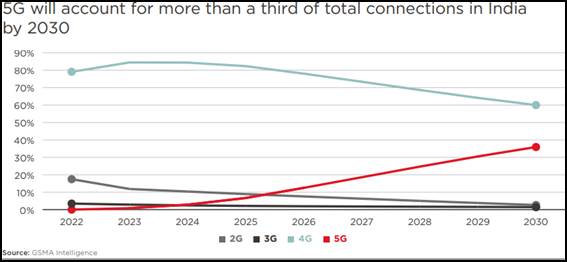Others
Get Set 5G!
India’s Digital Leap
Posted On: 29 NOV 2024 4:36PM
Introduction
 India is leading the charge in the adoption of 5G technology, marking a significant milestone in its digital transformation journey. With over 90 percent 5G coverage and affordable services driving accessibility, the country is witnessing an unprecedented surge in subscriptions. According to the Ericsson Mobility Report, November 2024, 5G subscriptions in the region comprising India, Nepal, and Bhutan are expected to surpass 27 crore by the end of 2024, accounting for 23 percent of total mobile subscriptions. By 2030, this number is projected to rise to an impressive 97 crore, making up 74 percent of all mobile connections in the region. This rapid rollout is revolutionizing sectors such as healthcare, education, and agriculture, while also bridging the digital divide in rural and underserved areas.
India is leading the charge in the adoption of 5G technology, marking a significant milestone in its digital transformation journey. With over 90 percent 5G coverage and affordable services driving accessibility, the country is witnessing an unprecedented surge in subscriptions. According to the Ericsson Mobility Report, November 2024, 5G subscriptions in the region comprising India, Nepal, and Bhutan are expected to surpass 27 crore by the end of 2024, accounting for 23 percent of total mobile subscriptions. By 2030, this number is projected to rise to an impressive 97 crore, making up 74 percent of all mobile connections in the region. This rapid rollout is revolutionizing sectors such as healthcare, education, and agriculture, while also bridging the digital divide in rural and underserved areas.
Globally, the 5G revolution is gaining momentum, with projections indicating that 5G subscriptions will overtake 4G by 2027. By the end of 2030, 5G is expected to carry 80 percent of the world’s total mobile data traffic, highlighting its transformative role in the future of connectivity. These global trends underscore the growing reliance on 5G technology to enable seamless communication, support advanced digital ecosystems, and foster economic growth across nations. India’s leadership in this space positions it as a key player in the worldwide shift toward next-generation connectivity.

Source: https://www.ericsson.com/4ad0df/assets/local/reports-papers/mobility-report/documents/2024/ericsson-mobility-report-november-2024.pdf
5G in India
With a population exceeding 1.4 billion and a fast-growing digital economy, India's demand for advanced, reliable, and high-speed connectivity has never been higher. The introduction of 5G will address several critical needs:
- Economic Growth: 5G is expected to contribute INR 36.4 trillion (approximately $455 billion) to India’s economy between 2023 and 2040, representing over 0.6% of its GDP by 2040.
- Sectoral Transformation: Key sectors such as manufacturing, retail, healthcare, and agriculture will benefit from 5G, enabling new operating models, improved efficiency, and innovative services like smart cities and digital governance.
- Digital Inclusion: While coverage gaps have decreased, a significant usage gap remains, particularly among women and lower-income groups. Affordable, accessible, and widespread 5G can bridge these divides, extending digital access to underserved populations.
5G technology offers ultra-low latency, massive machine-type communication, and unprecedented data speeds, all of which can significantly enhance digital service delivery in India. These capabilities are critical for India’s "Digital India" mission, aiming to ensure that every citizen benefits from the country’s digital transformation.
Government of India’s Initiatives in 5G Development
The Indian government has undertaken multiple initiatives to enable rapid, widespread 5G deployment, focusing on indigenous development, collaboration with the private sector, and regulatory reforms. Some of the key initiatives include:
Indigenous Telecom Stack: India has developed its 4G/5G telecom stack, including ORAN-compliant 5G equipment, under the BharatRAN project. This local infrastructure helps reduce dependency on foreign technology, strengthening India’s position as a global telecom manufacturing hub.
5G Test Beds: Through government funding, eight premier research institutes have created an indigenous, fully programmable 5G test bed to support research and innovation. This infrastructure allows companies to validate their prototypes and services while supporting future 5G and 6G advancements.
5G Labs: The government has sanctioned 100 labs across the country, with an allocation of Rs. 100 crores, to focus on 5G applications across various sectors, including education, healthcare, and urban management.
Digital Communications Innovation Square (DCIS) and Telecom Technology Development Fund (TTDF): These schemes collectively support startups and MSMEs in telecom R&D, providing funds and resources to develop indigenous 5G solutions. The TTDF, launched in 2022, allocates Rs. 500 crores annually to fund rural communication technology innovations.
Spectrum Auctions and Policy Reforms: The government has lowered spectrum prices, streamlined Right of Way (RoW) approvals, and established the GatiShakti Sanchar portal, simplifying infrastructure deployment. This policy environment promotes faster and more economical network expansion across urban and rural areas.

Conclusion
India is well-positioned to capitalize on the transformative opportunities provided by 5G technology, as emphasized in the Ericsson Mobility Report, November 2024. By focusing on expanding infrastructure, supporting indigenous R&D, fostering collaboration, and ensuring inclusive access to 5G services, the country can continue leading the global digital revolution in telecom. This approach will not only enhance connectivity but also drive innovation and growth across industries. As India progresses toward 6G, the robust groundwork laid by these initiatives will ensure sustained development, technological advancement, and a strong position of global leadership in the telecom sector.
References:
Kindly find the pdf file
*****
Santosh Kumar/ Ritu Kataria/ Arushi Singh/ Saurabh Kalia
(Features ID: 153402)
आगंतुक पटल : 656
Provide suggestions / comments